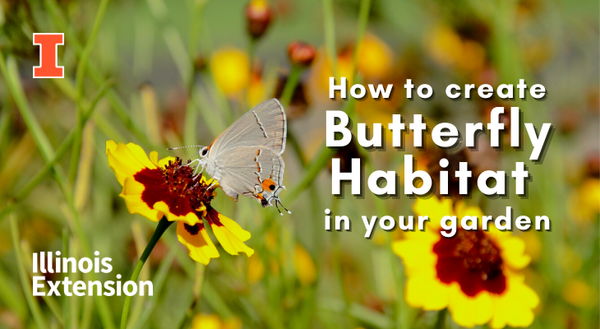
Butterflies are among the most popular, if not the most popular, insects out there. In fact, many cultures around the world use a butterfly as a symbol of the human soul. Many people consider a butterfly landing on you to be good luck, for example, this Irish blessing:
May the wings of the butterfly kiss the sun
And find your shoulder to light on,
To bring you luck, happiness, and riches
Today, tomorrow and beyond
In reality, the butterflies are probably just landing on you for the salt in your sweat...
Like many other types of insects, some butterflies, particularly monarchs, have seen population declines over the years. Scientists recently released their monarch population count for the winter of 2020/21. The monarch population has decreased 26% compared to the overwintering population of 2019/20. While a number of factors have led to population decreases, one of the most important is habitat loss. So, what can we do to make our landscapes more attractive to butterflies?
Location
It’s best to place butterfly gardens in areas that receive full sun (at least 6-8 hours of direct sun). Most plants/flowers that are attractive to butterflies are going to do best in full sun.
If you go out early in the morning before it starts to warm up, you’ll commonly see butterflies basking in the sun. Butterflies do this because they need to be warm to fly. While they’ll bask on any surface exposed to the sun (leaves, branches, soil, etc.), providing a large flat rock in direct sun will make your butterfly garden all that more attractive (the rock will absorb heat).
Food sources
If you want to attract butterflies to your yard, you’ll need to provide some food (see, humans and insects aren’t all that different), i.e., flowers. While butterflies may visit any type of flower, they tend to like flowers that are white, yellow, pink, orange, red, or purple. Butterflies have straw-like mouthparts and only feed on nectar, so choosing plants that provide ample nectar is important.
When it comes to selecting plants for your butterfly garden, native plants like black-eyed Susan, bee balm, blazing star, coneflower, and Joe-Pye weed can be used. Non-native plants like cosmos, zinnia, and Mexican sunflower can be used.
You also want to make sure you will have something blooming throughout the growing season. We tend to do a good job of having blooming plants during the summer but are often lacking in spring and fall. Plants such as goldenrod and asters are good options for fall, which is particularly important for monarch butterflies since they are migrating to Mexico.
When planting your butterfly garden, it’s a good idea to group your plants by color. Large groupings of flowers will be easier for butterflies to find. It’s also a good idea to have a variety of different bloom colors in your garden to attract a wider variety of butterflies.
If you want to take your butterfly garden to the next level, incorporate plants that will act as larval (caterpillar) food sources. Having larval food sources is important if you want to attract and keep butterflies around long-term. Many butterflies will only feed on a few different types of plants (for example, monarch larvae only feed on milkweed). If there is a specific type of butterfly or moth you want to attract, it’s a good idea to have its larval food source around too.
| Butterfly | Larval host |
|---|---|
| Black swallowtail | Carrot, parsley, dill, fennel, Queen Anne's lace |
| Eastern tiger swallowtail | Magnolia, tulip tree, cherry, ash |
| Monarch | Butterfly weed and other milkweeds |
| Great spangled fritillary | Violets |
| Buckeye | Snapdragon, plantain, Ruellia |
| Mourning Cloak | Willow, poplar, elm, hackberry, birch |
| Viceroy | Willow, poplar, aspen |
| Painted lady | Burdock, thistle, hollyhock, lupine |
| Clouded sulphur | Alfalfa, clover, vetch, and other legumes |
Shelter
Providing some sort of shelter for butterflies is also beneficial. Butterflies will need areas to ride out storms, pupate, and overwinter. Placing your butterfly garden in an area that is sheltered from wind can be beneficial. Trees and shrubs can make excellent windbreaks for your butterfly garden. They can also be a food source for both adults and caterpillars. Brush piles, leaf litter, and bunch grasses can also be sources of shelter.
Insecticides
When creating a butterfly garden, or any sort of pollinator garden, pesticide use should be limited. Since caterpillars will feed on plants, you must be willing to accept some plant damage. Remember, the reason you’re creating a butterfly garden is to provide food and shelter for these insects.
It’s also important to note that ‘weeds’ can be food sources for butterflies too. The dreaded violets in your lawn are a larval food source for the great spangled fritillary, and red admiral and question mark butterflies will feed on nettle.
Good Growing Tip of the Week: Butterfly gardens will attract more than butterflies. Other pollinators like beetles, moths, bees, wasps, as well as other types of insects, will also show up, which is a good thing.
References, and for more information:
Wagner, David L. Caterpillars of Eastern North America. Princeton (New Jersey): Princeton University Press, 2005.
Xerces Society, Scott Hoffman Black, Brianna Borders, Candace Fallon, Eric Lee-Mader, Matthew Shepperd. Gardening for Butterflies: How you can attract and protect beautiful, beneficial insects. Portland (Oregon): Timber Press, 2016.
Want to get notified when new Good Growing posts are available? SIGN UP HERE!